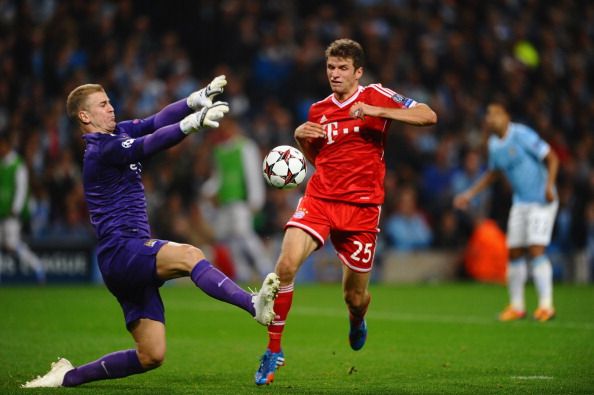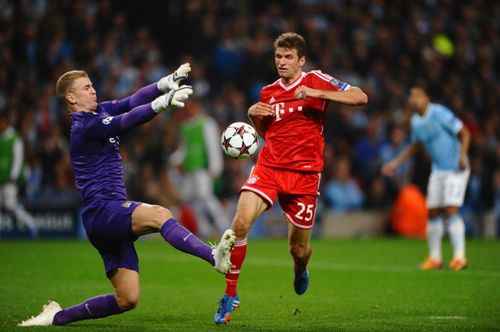
Manchester City 1-3 Bayern Munich: Tactical Analysis

Thomas Muller scores past Joe Hart during the UEFA Champions League Group D match between Manchester City and FC Bayern Munich at Etihad Stadium on October 2, 2013 in Manchester, England. (Getty Images)
Yet another big game came our way in the UEFA Champions League in what has been a great season of European football so far. Guardiola and his Bayern Munich side went to the Etihad, expecting to win.Manchester City also set up to get 3 points in their home game.
The home team started with the first choice centre back pairing of Kompany and Nastasic. Clichy and Richards were the two wing backs. In midfield, Toure and Fernandinho started behind Nasri, Aguero and Jesus Navas. The lone man up front was Edin Dzeko.
The European champions set up an attacking line up as usual. Dante and Boateng were the centre backs who started the game for Bayern. Rafinha and Alaba were chosen to start as the wide defenders, but were detailed to add in attack. Philip Lahm began the game in his now customary position of defensive midfielder, with Schweinsteiger and Kross forming the midfield trio. Muller was the designated striker, with ‘Robbery’ patrolling the wings.
Bayern Pressing
One of the things that made Guardiola’s Barcelona so special was the way in which they pressed and won the ball back from the opposition so quickly. Guardiola seems to have brought this along with him to Bayern Munich, and Der Roten were absolutely fantastic when winning the ball back from the opposition tonight. They pressed City relentlessly, especially in the deeper areas of City’s half. The pressing was different in different parts of the pitch from Bayern. In City’s half, they were chasing down the ball with ferocity, and pressing with an intention to win the ball back immediately. This was on show for their third goal, when Kroos tackled Fernandinho to start the move. However, the intensity of the press did vary, especially when City did manage to get past the initial wave of pressure. In the moments this occurred, the Bayern backline dropped off quite efficiently.
Of course, this pressing had an adverse effect on Bayern as the game wore on, and City came into it a lot more towards the end, primarily because of fatigue affecting the quality of the pressing from Bayern.
Bayern Attacking Shape
Something that Guardiola has implemented quite well at Bayern is the shape they use to facilitate ball retention. As shown in the tactics graph, the centre backs go wide, with Philip Lahm dropping between them. Mostly, Rafinha and Alaba go towards the middle of the field to receive and play their passes, along with Schweinsteiger. They form a midfield trio, with the middle player, Schweinsteiger in this case, moving up and down to find space and play passes. Kroos, was the 1, who forms more of a part of an attacking quartet, along with Muller, Robben and Ribery.
Of course, in this game, there were a few changes to this standard model. Alaba and Rafinha for example, provided a lot more width, especially Alaba. There was a lot of switching of positions across the team as well, with Schweinsteiger and Kroos swapping quite often. Ribery and Robben, too, weren’t averse to drifting in and playing centrally at times. Similarly, Muller too went wide when the situation demanded his presence in those areas.